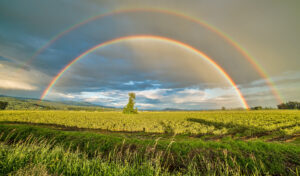Physical Address
23,24,25 & 26, 2nd Floor, Software Technology Park India, Opp: Garware Stadium,MIDC, Chikalthana, Aurangabad, Maharashtra – 431001 India
Physical Address
23,24,25 & 26, 2nd Floor, Software Technology Park India, Opp: Garware Stadium,MIDC, Chikalthana, Aurangabad, Maharashtra – 431001 India

If you are tired of reading about the negative impacts of human-induced Climate Change and are looking for a ray of sunshine, or for a rainbow even, this article is just for you. It has come to light that Climate Change has brought some good news for humanity, although this might be the only one!
According to a recent study conducted by scientists at the University of Hawai’i (UH) at Manoa, there will be more opportunities to observe rainbows as a result of climate change. The authors of the study predict that by 2100, there will be 5% more days with rainbows than there were at the start of the twenty-first century at average geographical locations on Earth.
The biggest increases in rainbow occurrence will occur in northern latitudes and very high elevations, where warming is projected to result in less snow and more rain. However, regions that may get less rainfall due to climate change, like the Mediterranean, would likely experience fewer rainbow days.
When sunlight is refracted by water droplets, rainbows are created. Rainbows consequently require both sunlight and precipitation. The warming of the climate caused by human activity like the combustion of fossil fuels alters rainfall patterns, amounts, and cloud cover.
“Living in Hawai’i, I felt grateful that stunning, ephemeral rainbows were a part of my daily life,” said the lead author of the study, Kimberly Carlson, who is now at New York University’s Department of Environmental Studies. “I wondered how climate change might affect such rainbow viewing opportunities.”
“Climate change will generate pervasive changes across all aspects of the human experience on Earth. Shifts in intangible parts of our environment — such as sound and light — are part of these changes and deserve more attention from researchers,” said Carlson.
The question piqued the interest of Camilo Mora of the UH Manoa Geography and Environment department, who proposed it as the subject of a study for one of his graduate classes.
The researchers said that while it is often studied how climate change directly affects people’s health and livelihoods, very few studies have been conducted to examine the effect of climate change on the aesthetic qualities of our environment, and no one had bothered to map rainbow occurrences, much less under climate change.
The study found “that the average terrestrial location on Earth currently has 117 ± 71 days per year with conditions suitable for rainbows. By 2100, climate change is likely to generate a 4.0–4.9 % net increase in mean global annual rainbow-days (i.e., days with at least one rainbow), with the greatest change under the highest emission scenario. Around 21–34 % of land areas will lose rainbow-days and 66–79 % will gain rainbow-days, with rainbow gain hotspots mainly in high-latitude and high-elevation regions with smaller human populations.”
A team made up of UH Manoa students looked over pictures shared on the social media site Flickr to find the answer to this question. Tens of thousands of images from all around the world marked with the term “rainbow” were filtered through in order to find rainbows caused by raindrops reflecting light.
“We had to sort through photos of rainbow artwork, rainbow flags, rainbow trout, rainbow eucalyptus, and rainbow foods to find the real rainbows,” said Amanda Wong, a co-author on the paper.
The researchers then used maps of precipitation, cloud cover, and sun angle to train a model for predicting rainbows based on the locations of rainbow photos. Finally, they used their model to forecast rainbow occurrences in the present and the future over land masses around the world. According to the model, islands are hotspots for rainbows.
“Islands are the best places to view rainbows,” according to Steven Businger, professor of Atmospheric Sciences in SOEST. “This is because island terrain lifts the air during daily sea breezes, producing localized showers surrounded by clear skies that let the sun in to produce majestic rainbows.”
There will likely be a few more days with rainbows each year in the Hawaiian Islands, which have recently been called the “rainbow capital of the world.” The authors did not go into detail about how variations in rainbow incidence can impact people’s quality of life. However, rainbows are beautiful and have played a significant role in human culture throughout history and today.